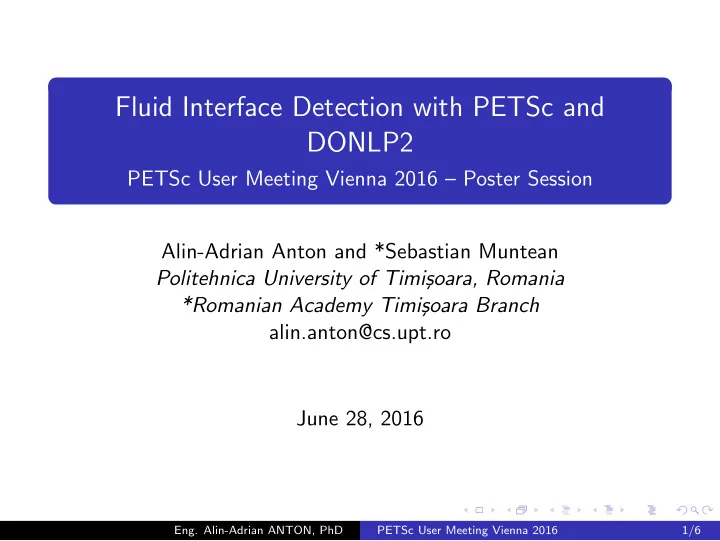

Fluid Interface Detection with PETSc and DONLP2 PETSc User Meeting Vienna 2016 – Poster Session Alin-Adrian Anton and *Sebastian Muntean Politehnica University of Timi¸ soara, Romania *Romanian Academy Timi¸ soara Branch alin.anton@cs.upt.ro June 28, 2016 Eng. Alin-Adrian ANTON, PhD PETSc User Meeting Vienna 2016 1/6
Vortex rope (self-induced instability) taking place in swirling flows the stalled region is filled with stagnant water 3D unsteady flow is modeled considering a 2D axisymmetric steady flow the flowing-stalled fluid interface can be determined using interface capturing techniques (ICaT) and interface tracking techniques (ITrT) Eng. Alin-Adrian ANTON, PhD PETSc User Meeting Vienna 2016 2/6
Two-dimensional axisymmetric flow numerical simulation with stagnant region computed with ICaT Eng. Alin-Adrian ANTON, PhD PETSc User Meeting Vienna 2016 3/6
SWIRL2D 2D boundaries ( x,r ) + PROBLEM (1) interface boundary ( r i , i=1...n ) + DATA boundary conditions initial guess (2) PROBLEM inter ace boundary (r i , i=1...n ) f PARAMETERS Computational domain (3) generation (1D + 2D) PETSc interface boundary (4) Mesh generation TRIANGLE new (1D + 2D) interface boundary (5) 2D flow ( r i , i=1...n ) PETSc computation (8) (6) GNU GSL Objective F, F* function (7) min F NO DONLP2 max F* SQP m ethod YES (10) Optimum Optimum (9) interface boundary 2D flow solution TECPLOT ( r i , i=1...n ) Eng. Alin-Adrian ANTON, PhD PETSc User Meeting Vienna 2016 4/6
the moving knots are used for SQP interface optimization the interface is obtained through interpolation using cubic splines a new mesh is generated using TRIANGLE and the 2D section axisymmetric flow is solved using the finite element method (FEM) Eng. Alin-Adrian ANTON, PhD PETSc User Meeting Vienna 2016 5/6
SWIRL2D solution (upper meridian half-plane) and FLUENT2D axisymmetric inviscid solution (lower meridian half-plane) Eng. Alin-Adrian ANTON, PhD PETSc User Meeting Vienna 2016 6/6
Recommend
More recommend